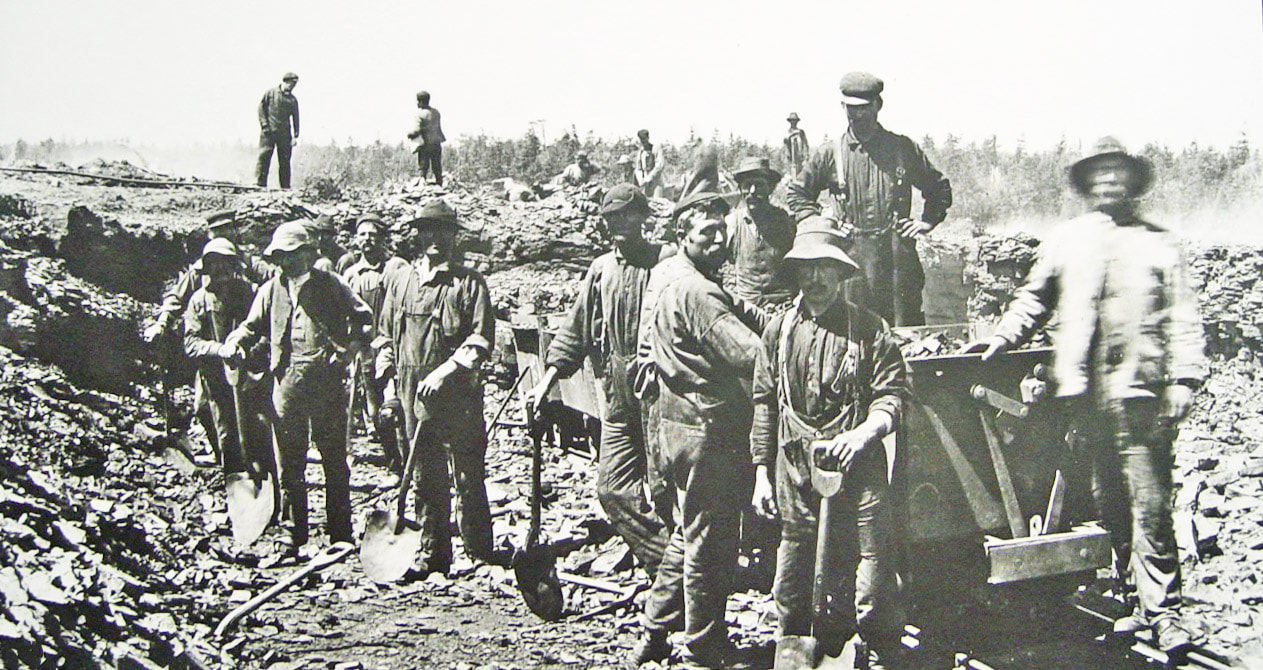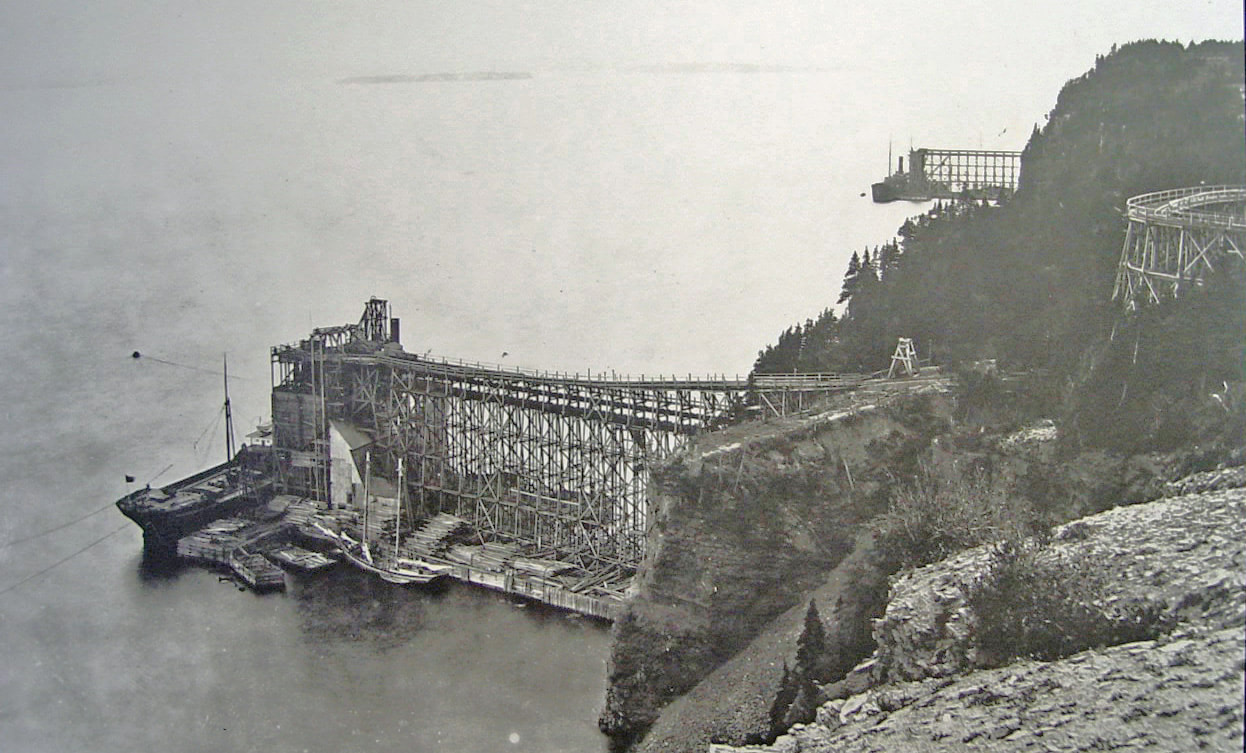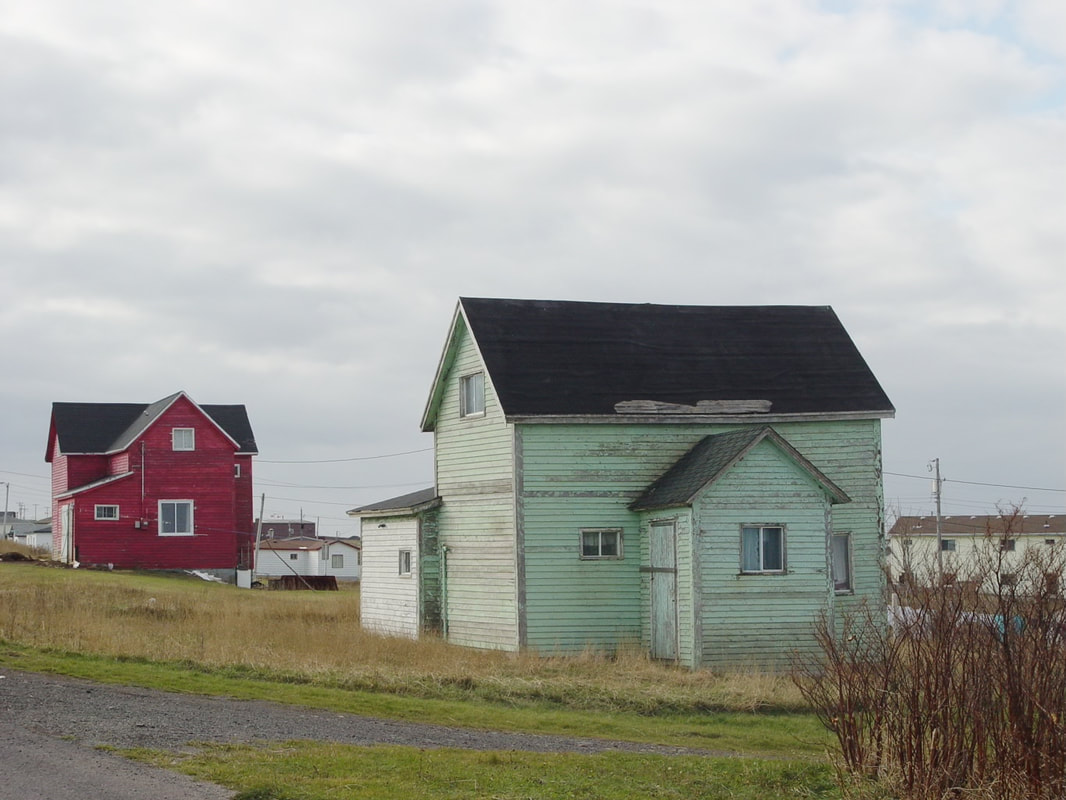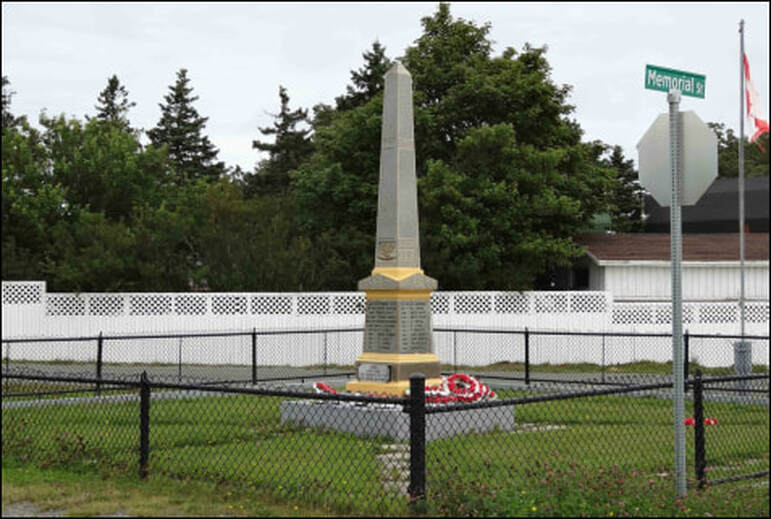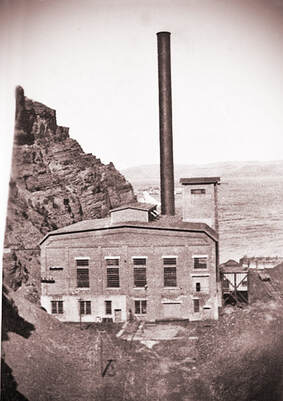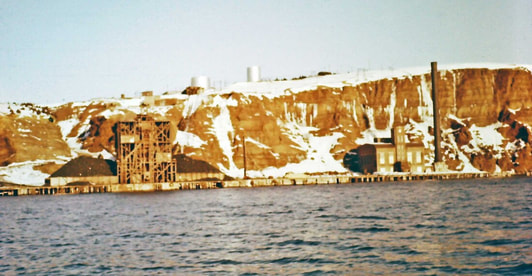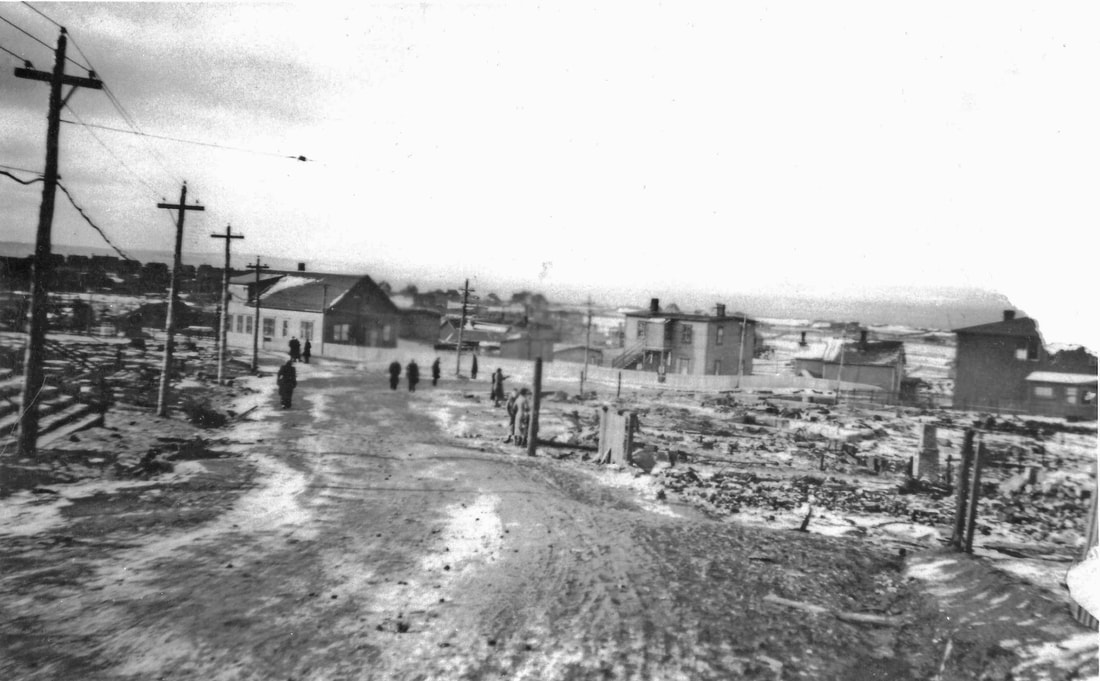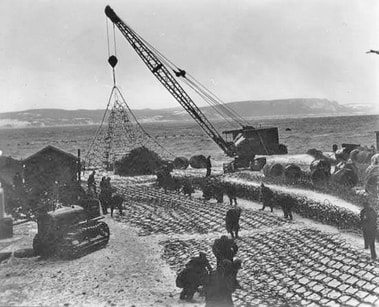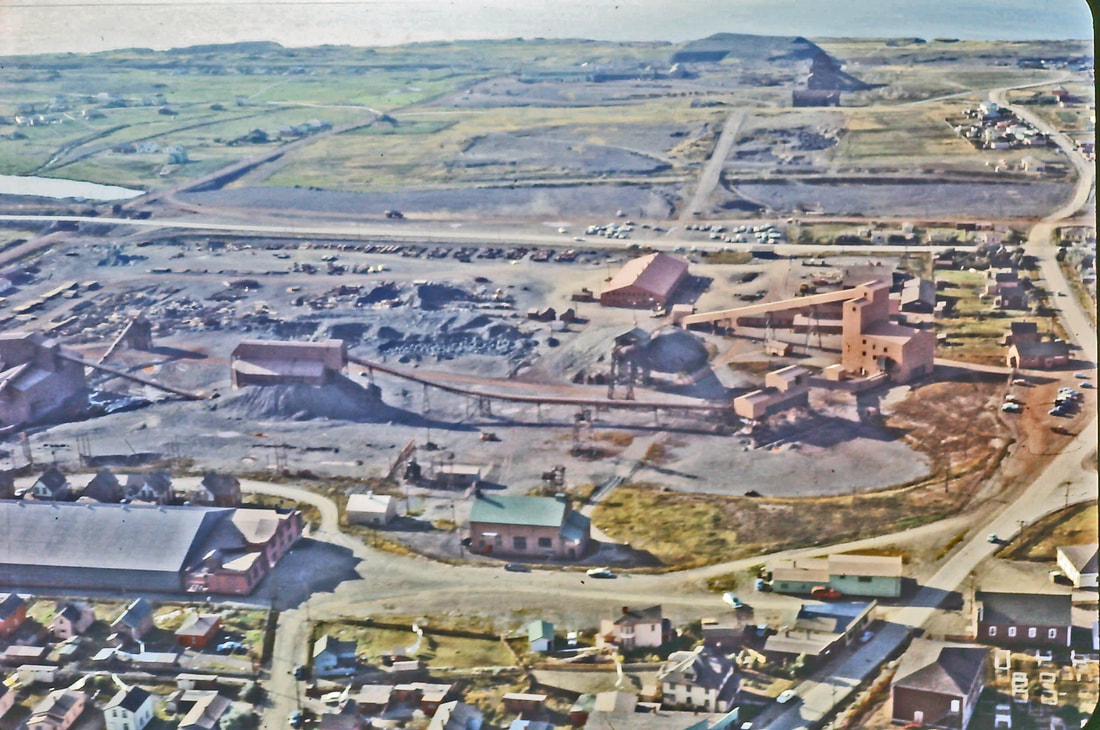HISTORY
MINING HISTORY
MINING HISTORY
TIME-LINE OF THE HISTORY OF THE WABANA MINES
by Gail Hussey-Weir
Created 2021 / Updated April 1, 2022
by Gail Hussey-Weir
Created 2021 / Updated April 1, 2022
Author's Note: This brief history of the Wabana Mines is an 8-part series in which each part focuses on a specific era in the progression of the mining operations. The parts as a whole form a timeline of events in the life of the mines. I wanted to keep it as concise as possible, so there is a lot of detail left out. You can read more about the history of Bell Island on this website under "History" in the top menu, including more "Mining History" and much more about the very interesting lives of "The Messrs. Butler of Topsail," who saw the signs of earlier mining activity on Bell Island and brought it to the world's attention at just the right time. There are also several good articles of mining history under "Publications" in the top menu, especially the Arthur House and F.F. Jardine articles.
History of the Wabana Mines, Part 1, 1891-1898
In 1891, the population of Bell Isle (as it was then known) was 709 men, women and children, living in 135 households at The Beach, The Front, Lance Cove and Freshwater (west). Their occupation was fishing and farming.
On August 4, 1892, Jabez Butler, on behalf of a group of 6 who would become known as “The Messrs. Butler of Topsail,” filed three applications to search for minerals at The Back (north side) of Bell Isle. Thus began events that would change the history of Bell Island forever, and would turn a quiet, pastoral island into a busy center of industry for over 71 years.
In May 1893, the Butlers engaged St. John’s merchants Shirran & Pippy as their agents in finding a developer for the mining property. They contacted the New Glasgow Coal, Iron & Railroad Company of Nova Scotia (hereafter referred to as the “Scotia Company”), who happened to be looking for a reliable source of iron ore at that very time. Scotia sent their Chief Engineer, R.E. Chambers, to examine the iron ore beds.
In September 1894, Scotia leased the mining rights from the Butlers, and Chambers began making plans for the first pier and tramway across the Island. When surface mining began in 1895, Scotia’s Secretary, Thomas Cantley, named the mine site “Wabana.” Most of the early miners and labourers were former fisher-farmers, first from Bell Island itself, then augmented by men from all around Conception Bay.
In late December 1895, the first shipment of iron ore left the Island for Scotia’s steel mill in Ferrona, NS. Most of the ore went to Nova Scotia in the beginning, with small amounts sold in the U.S., Rotterdam and Glasgow, Scotland. Operations were seasonal, starting in late spring after the Arctic ice moved out of the bay and ceasing in November.
In 1898, Germany became a major customer and would remain so throughout the life of the mines. By then, 450 miners were employed.
The photo below shows some of those early miners. It is entitled "West Mines, Scotia Company" from a 1902-03 album at the Bell Island Community Museum.
On August 4, 1892, Jabez Butler, on behalf of a group of 6 who would become known as “The Messrs. Butler of Topsail,” filed three applications to search for minerals at The Back (north side) of Bell Isle. Thus began events that would change the history of Bell Island forever, and would turn a quiet, pastoral island into a busy center of industry for over 71 years.
In May 1893, the Butlers engaged St. John’s merchants Shirran & Pippy as their agents in finding a developer for the mining property. They contacted the New Glasgow Coal, Iron & Railroad Company of Nova Scotia (hereafter referred to as the “Scotia Company”), who happened to be looking for a reliable source of iron ore at that very time. Scotia sent their Chief Engineer, R.E. Chambers, to examine the iron ore beds.
In September 1894, Scotia leased the mining rights from the Butlers, and Chambers began making plans for the first pier and tramway across the Island. When surface mining began in 1895, Scotia’s Secretary, Thomas Cantley, named the mine site “Wabana.” Most of the early miners and labourers were former fisher-farmers, first from Bell Island itself, then augmented by men from all around Conception Bay.
In late December 1895, the first shipment of iron ore left the Island for Scotia’s steel mill in Ferrona, NS. Most of the ore went to Nova Scotia in the beginning, with small amounts sold in the U.S., Rotterdam and Glasgow, Scotland. Operations were seasonal, starting in late spring after the Arctic ice moved out of the bay and ceasing in November.
In 1898, Germany became a major customer and would remain so throughout the life of the mines. By then, 450 miners were employed.
The photo below shows some of those early miners. It is entitled "West Mines, Scotia Company" from a 1902-03 album at the Bell Island Community Museum.
History of the Wabana Mines, Part 2, 1899-1906
Early in 1899, Scotia purchased the mining rights from the Butlers, then sold a portion to Dominion Coal Company of Cape Breton (known locally as “Dominion Company”). This set the stage for a massive steel industry in Nova Scotia based on Wabana’s iron ore. Both companies built steel plants in Cape Breton, which would utilize only that iron ore for the next 50 years. With 2 companies now mining on Bell Island, a second shipping pier was built and new tramways were constructed across the Island.
By 1900, there were 1,600 workers. Wabana’s first mine union was formed when Dominion tried to reduce the number of men loading ore cars. A strike ensued and brought threats of violence, which focused attention on the need for a police presence. The strike and union were short-lived, but the Island got its first court house and police station. A telegraph cable was also installed from Portugal Cove to Bell Island. With the growing industry and population came more amenities, including: passenger ferries, housing, schools, churches, shops, hotels, restaurants, court house, telegraph and customs offices, health care, sports, performing arts and entertainment.
By 1903, the depletion of surface ore saw both companies begin underground mining.
In March 1905, Scotia Company began driving the first slope beneath Conception Bay. (This was their No. 2 Slope, which would be renamed No. 6 after 1922.) Demand for steel was such that mining was now year-round with only a short break for Christmas week. In May, 1906, an agreement was reached by which Scotia Company commenced driving a pair of slopes through Dominion Company's submarine holdings in order to reach their own, which was further off shore.
In 1906, there were no safety regulations, and accidents in the Wabana Mines were increasing, causing the Newfoundland Government to legislate its first Regulation of Mines Act. Among other things, it required mine inspections and accident investigations.
The photo below shows Dominion Pier and Round-about in the foreground, from a 1902-03 album at the Bell Island Community Museum. This had been Scotia's first pier, which it sold to Dominion along with part of its mine property and its first ore car tramway in 1899. Scotia's new pier can be seen in the background.
By 1900, there were 1,600 workers. Wabana’s first mine union was formed when Dominion tried to reduce the number of men loading ore cars. A strike ensued and brought threats of violence, which focused attention on the need for a police presence. The strike and union were short-lived, but the Island got its first court house and police station. A telegraph cable was also installed from Portugal Cove to Bell Island. With the growing industry and population came more amenities, including: passenger ferries, housing, schools, churches, shops, hotels, restaurants, court house, telegraph and customs offices, health care, sports, performing arts and entertainment.
By 1903, the depletion of surface ore saw both companies begin underground mining.
In March 1905, Scotia Company began driving the first slope beneath Conception Bay. (This was their No. 2 Slope, which would be renamed No. 6 after 1922.) Demand for steel was such that mining was now year-round with only a short break for Christmas week. In May, 1906, an agreement was reached by which Scotia Company commenced driving a pair of slopes through Dominion Company's submarine holdings in order to reach their own, which was further off shore.
In 1906, there were no safety regulations, and accidents in the Wabana Mines were increasing, causing the Newfoundland Government to legislate its first Regulation of Mines Act. Among other things, it required mine inspections and accident investigations.
The photo below shows Dominion Pier and Round-about in the foreground, from a 1902-03 album at the Bell Island Community Museum. This had been Scotia's first pier, which it sold to Dominion along with part of its mine property and its first ore car tramway in 1899. Scotia's new pier can be seen in the background.
History of the Wabana Mines, Part 3, 1907-1914
Around 1907, electricity began replacing steam for the driving of engines and mine equipment. Scotia Company had an electrical plant adjoining their shipping pier for ventilating, draining and lighting the mine and new infrastructure was being added to prepare for submarine mining.
In 1907-08, most of the Dominion Company saddle-roof houses were built in Dominion Range (north of Bennett Street), also at West Mines (south of West Mines Road), at No. 4 Range and in East No. 1. By 1908, 2,350 miners were employed, many of whom were commuters, necessitating the building of more miners’ shacks and mess houses.
In 1909, Scotia Company entered its own submarine property, about 4000 feet from shore. In 1910, at 6000 feet from shore, they were ready to start submarine mining.
By the end of 1910, eight million tons of iron ore had been shipped from Bell Island since 1895. Miners were now being actively recruited from all over Newfoundland.
By 1911, the Scotia Company houses on Scotia Ridge and at Bridal Avenue were being built.
1912-13 saw many advancements with the permanent population now at 3,084, and that did not include commuting miners. Amenities included 10 schools, 7 churches, 4 halls, 3 hotels, 30 shops, a Bank, a weekly newspaper, the first local council, and the first enclosed skating rink. The Tramway to carry passengers and freight from the wharf at The Beach to the top of the steep hillside opened late fall 1913. An electric plant to light the Roman Catholic Church on The Green heralded the beginning of a lighting system that would spread out over time in that area.
In August 1914, the First World War brought everything on Bell Island to a standstill. The mines were closed for the rest of that year and all sports and amusements were cancelled.
The photo below shows two of Dominion Company's saddle-roof houses built c.1907 at Dominion No. 1 (The East End). The green house shows the front of the house, with porch and a front door that was rarely used. The red house shows the back of the house, where the kitchen was located, and side porch and back door, which was used as the main entry. In 2005 when this photo was taken, these were the only 2 remaining of what had been 6 identical back-to-back Company houses in this area. Photo by Gail Weir.
In 1907-08, most of the Dominion Company saddle-roof houses were built in Dominion Range (north of Bennett Street), also at West Mines (south of West Mines Road), at No. 4 Range and in East No. 1. By 1908, 2,350 miners were employed, many of whom were commuters, necessitating the building of more miners’ shacks and mess houses.
In 1909, Scotia Company entered its own submarine property, about 4000 feet from shore. In 1910, at 6000 feet from shore, they were ready to start submarine mining.
By the end of 1910, eight million tons of iron ore had been shipped from Bell Island since 1895. Miners were now being actively recruited from all over Newfoundland.
By 1911, the Scotia Company houses on Scotia Ridge and at Bridal Avenue were being built.
1912-13 saw many advancements with the permanent population now at 3,084, and that did not include commuting miners. Amenities included 10 schools, 7 churches, 4 halls, 3 hotels, 30 shops, a Bank, a weekly newspaper, the first local council, and the first enclosed skating rink. The Tramway to carry passengers and freight from the wharf at The Beach to the top of the steep hillside opened late fall 1913. An electric plant to light the Roman Catholic Church on The Green heralded the beginning of a lighting system that would spread out over time in that area.
In August 1914, the First World War brought everything on Bell Island to a standstill. The mines were closed for the rest of that year and all sports and amusements were cancelled.
The photo below shows two of Dominion Company's saddle-roof houses built c.1907 at Dominion No. 1 (The East End). The green house shows the front of the house, with porch and a front door that was rarely used. The red house shows the back of the house, where the kitchen was located, and side porch and back door, which was used as the main entry. In 2005 when this photo was taken, these were the only 2 remaining of what had been 6 identical back-to-back Company houses in this area. Photo by Gail Weir.
History of the Wabana Mines, Part 4, 1915-1921
The First World War, which began in 1914, had a profound effect on Bell Island, with the first result being the loss of the overseas iron ore market, throwing many men out of work for some months. It then continued to affect operations over the next few years. More drastically, a final total of 200 boys and men enlisted from Bell Island, 29 of whom died as a result of the war, with many more wounded.
It was June 1915 before both mining companies were getting back to production. During these war years, Dominion’s No. 2 and No. 4 mines and Scotia’s No. 3 were being driven into their submarine areas, making four submarine slopes in all. (Scotia's No. 2 submarine had been reached in 1910.)
By 1917, Bell Island’s population balance had shifted. Where previously the majority of permanent residents had lived at The Front, more than half the population now lived in close proximity to the mines, reasonable considering that most people walked to work. The mines area now formed its own Local Council.
In 1919, 1,500 men were working full time for the 2 companies. Although World War I had ended in late 1918, its devastating impact on the British economy was about to be felt on Bell Island.
In 1920-21, British industrialists, looking to revive the economy of the United Kingdom, conspired with the presidents of Nova Scotia Steel & Coal Company (NSSCC) and Dominion Iron & Steel Company (DISCO), operators of the Wabana mines, to create Canada’s largest corporate merger, forming the British Empire Steel Corporation (BESCO). BESCO absorbed NSSCC, DISCO, Halifax Shipyards, most of Nova Scotia’s coal mines, Aguathuna, and the Wabana iron ore properties. This would have immediate and lasting implications for Bell Island.
Finally, in 1921, the erection on Davidson Avenue of the War Memorial, a monument to Bell Island’s fallen soldiers and sailors, allowed the community to feel that they had honoured their war dead and brought a sense of closure to that terrible period in our history. The photo below shows the War Memorial in 2016.
It was June 1915 before both mining companies were getting back to production. During these war years, Dominion’s No. 2 and No. 4 mines and Scotia’s No. 3 were being driven into their submarine areas, making four submarine slopes in all. (Scotia's No. 2 submarine had been reached in 1910.)
By 1917, Bell Island’s population balance had shifted. Where previously the majority of permanent residents had lived at The Front, more than half the population now lived in close proximity to the mines, reasonable considering that most people walked to work. The mines area now formed its own Local Council.
In 1919, 1,500 men were working full time for the 2 companies. Although World War I had ended in late 1918, its devastating impact on the British economy was about to be felt on Bell Island.
In 1920-21, British industrialists, looking to revive the economy of the United Kingdom, conspired with the presidents of Nova Scotia Steel & Coal Company (NSSCC) and Dominion Iron & Steel Company (DISCO), operators of the Wabana mines, to create Canada’s largest corporate merger, forming the British Empire Steel Corporation (BESCO). BESCO absorbed NSSCC, DISCO, Halifax Shipyards, most of Nova Scotia’s coal mines, Aguathuna, and the Wabana iron ore properties. This would have immediate and lasting implications for Bell Island.
Finally, in 1921, the erection on Davidson Avenue of the War Memorial, a monument to Bell Island’s fallen soldiers and sailors, allowed the community to feel that they had honoured their war dead and brought a sense of closure to that terrible period in our history. The photo below shows the War Memorial in 2016.
History of the Wabana Mines, Part 5, 1922-1930
Even though the two mining companies had been absorbed into one large corporation, BESCO, in 1921, it was 1922 before this merger came to fruition at Wabana and the two became one.
By 1922, the post-war depression was underway. Ore was being stock-piled due to lack of markets and the mines alternated between full shut-downs and shortened work weeks. The “Whack Road” was started as a make-work program for out-of-work miners. It opened as Middleton Avenue in 1928 linking West Mines to Freshwater for the first time.
1923 was another bad year and many young men left the Island for Canada and the U.S. to seek work. The large turbo-electric power plant went into operation at Dominion Pier in September.
In 1924, Wabana Mines were the largest in the British Empire and 4th on the World List of Mines. With a population of 4,400, Bell Island was made an Electoral District. Meanwhile, employment, when it existed, was restricted to the 900 workers who had their homes on the Island. While Wabana miners managed to survive the low wages and sporadic unemployment of the BESCO years, their fellow coal and steel workers in Nova Scotia were organized into a strong union that had been striking whenever the corporation attempted to lower wages, cut hours or limit rights.
In 1925, when BESCO cut wages in Nova Scotia by 20%, the resulting strike turned violent with the shooting death of a miner. The ongoing strikes ultimately caused the collapse of BESCO.
In 1926, Wabana unemployment was still high when the National Trust Company took over from BESCO and temporarily acted as “receiver-manager” for the next 4 years.
From 1927-29, prosperity returned to Bell Island with a new contract from Germany. 1929 was one of the most prosperous years to date in the history of the mines, but it was also the year of the Stock Market crash in the United States, which would soon be felt around the world.
In June 1930, control of the former BESCO passed to the Dominion Steel and Coal Corporation, known as DOSCO. 2,000 men were now employed but, by the end of 1930, there were already signs of the coming Depression with the mines being put on half-time due to less demand for iron ore.
The William Lindsay photo below left shows the west side of the turbo-electric power plant that began operation in 1923 at Dominion Pier. The V.J. Southey photo on the right shows the power plant in relation to Dominion Pier seen from the water.(Photos courtesy of A&SC, MUN Library, COLL-202.)
By 1922, the post-war depression was underway. Ore was being stock-piled due to lack of markets and the mines alternated between full shut-downs and shortened work weeks. The “Whack Road” was started as a make-work program for out-of-work miners. It opened as Middleton Avenue in 1928 linking West Mines to Freshwater for the first time.
1923 was another bad year and many young men left the Island for Canada and the U.S. to seek work. The large turbo-electric power plant went into operation at Dominion Pier in September.
In 1924, Wabana Mines were the largest in the British Empire and 4th on the World List of Mines. With a population of 4,400, Bell Island was made an Electoral District. Meanwhile, employment, when it existed, was restricted to the 900 workers who had their homes on the Island. While Wabana miners managed to survive the low wages and sporadic unemployment of the BESCO years, their fellow coal and steel workers in Nova Scotia were organized into a strong union that had been striking whenever the corporation attempted to lower wages, cut hours or limit rights.
In 1925, when BESCO cut wages in Nova Scotia by 20%, the resulting strike turned violent with the shooting death of a miner. The ongoing strikes ultimately caused the collapse of BESCO.
In 1926, Wabana unemployment was still high when the National Trust Company took over from BESCO and temporarily acted as “receiver-manager” for the next 4 years.
From 1927-29, prosperity returned to Bell Island with a new contract from Germany. 1929 was one of the most prosperous years to date in the history of the mines, but it was also the year of the Stock Market crash in the United States, which would soon be felt around the world.
In June 1930, control of the former BESCO passed to the Dominion Steel and Coal Corporation, known as DOSCO. 2,000 men were now employed but, by the end of 1930, there were already signs of the coming Depression with the mines being put on half-time due to less demand for iron ore.
The William Lindsay photo below left shows the west side of the turbo-electric power plant that began operation in 1923 at Dominion Pier. The V.J. Southey photo on the right shows the power plant in relation to Dominion Pier seen from the water.(Photos courtesy of A&SC, MUN Library, COLL-202.)
History of the Wabana Mines, Part 6, 1931-1939
In early 1931, there were 1,000 miners commuting to Bell Island for work. By year’s end, all these mainland men were laid off as the Great Depression set in. The slowdown in operations was so severe, DOSCO was leasing land to employees to grow vegetables to supplement lost income. Work was begun creating the sports field with out-of-work miners volunteering labour. Undersea cables brought hydroelectric power to the Island for the first time.
In 1932, mining was down to 2 days a week; office staff were on half-time. Pay rates were cut. Germany was Wabana’s only customer that year. $1/day was paid for work on the Sports Field.
In 1933, the slow-down in the mines continued, putting many people on Government relief. All able-bodied men on relief were put to work doing community clean up, repairing bridges over tramways and laying drains for the Town Square horse fountain. The lowest point of the Depression came in September when No. 3 Mine closed, leaving only No. 6 Mine to provide employment 2 days a week for 1,100 miners. If not for Germany, the Wabana mines would have been closed in these Depression years and there would have been complete destitution for the people of Bell Island.
In 1934, iron ore production increased when the Sydney Steel Plant returned to 60% production.
In 1935, Bell Island’s permanent population was 6,160 and mining activity continued to improve with 2 mines operating at full capacity that Fall for the first time since 1930.
1936 was another roller-coaster year, with production up, then down, then up again.
1937 began with a major disaster when 20 shops and homes on Town Square were destroyed by fire. For the first time since the Great Depression began, full-time employment for both resident and mainland miners returned that winter.
1938 saw both the Anglican and the Roman Catholic Parishes opening new schools and enlarging others. The Avalon Telephone Co. took over the telephone system from DOSCO.
World War II broke out in September 1939. Up to that point, everything was in full swing on Bell Island with 2,200 men employed. The last shipment of Wabana iron ore left for Germany on August 26th.
The photo below is of Town Square on January 15, 1937, the day after fire destroyed 20 shops and homes. The building on the left is the former Company Survey Office, now called "The Red Building." Just right of center is the former Company Surgery. Right of that is the former William Somerton house, which is still standing. Photo courtesy of A&SC, MUN Library, COLL-202.
In 1932, mining was down to 2 days a week; office staff were on half-time. Pay rates were cut. Germany was Wabana’s only customer that year. $1/day was paid for work on the Sports Field.
In 1933, the slow-down in the mines continued, putting many people on Government relief. All able-bodied men on relief were put to work doing community clean up, repairing bridges over tramways and laying drains for the Town Square horse fountain. The lowest point of the Depression came in September when No. 3 Mine closed, leaving only No. 6 Mine to provide employment 2 days a week for 1,100 miners. If not for Germany, the Wabana mines would have been closed in these Depression years and there would have been complete destitution for the people of Bell Island.
In 1934, iron ore production increased when the Sydney Steel Plant returned to 60% production.
In 1935, Bell Island’s permanent population was 6,160 and mining activity continued to improve with 2 mines operating at full capacity that Fall for the first time since 1930.
1936 was another roller-coaster year, with production up, then down, then up again.
1937 began with a major disaster when 20 shops and homes on Town Square were destroyed by fire. For the first time since the Great Depression began, full-time employment for both resident and mainland miners returned that winter.
1938 saw both the Anglican and the Roman Catholic Parishes opening new schools and enlarging others. The Avalon Telephone Co. took over the telephone system from DOSCO.
World War II broke out in September 1939. Up to that point, everything was in full swing on Bell Island with 2,200 men employed. The last shipment of Wabana iron ore left for Germany on August 26th.
The photo below is of Town Square on January 15, 1937, the day after fire destroyed 20 shops and homes. The building on the left is the former Company Survey Office, now called "The Red Building." Just right of center is the former Company Surgery. Right of that is the former William Somerton house, which is still standing. Photo courtesy of A&SC, MUN Library, COLL-202.
History of Wabana Mines, Part 7, 1940-1949
As with WWI, WWII had profound consequences for Bell Island and the Wabana Mines. Once again overseas markets were lost, causing slow-downs in the mines and lay-offs. Many miners found work on the American bases in St. John’s and Argentia.
In April 1940, the mines went on half-time due to some ore carriers being engaged for military use. DOSCO advised all workers with garden allotments to plant them as they had done during the 1930s Depression. This situation continued for the duration of the war, ie. through 1945.
On November 10, 1940, two ferries collided in The Tickle, causing the deaths of 22 people, mostly miners.
In 1941, D.I. (Nish) Jackman formed the Wabana Mine Workers’ Union, spurred on by the ongoing work shortage. It was Wabana’s first union with staying power and lasted till the mines closed in 1966. Also in 1941, Torbay Airport (forerunner of St. John’s International Airport) was constructed “to protect Bell Island from raids by German warplanes.”
On September 5, 1942, the war came to Bell Island when a German U-boat sank 2 ore boats anchored in The Tickle killing 29 sailors. On November 2, 1942, another German U-boat sank 2 more ore boats killing 36 sailors. It was said that the Germans were “throwing back what they had bought a few years before!”
In August 1945, World War II ended; 32 Bell Islanders had been killed. Throughout the war, the 1st Coastal Defence Battery was stationed on Bell Island, in barracks situated on Memorial Street. In November 1945, those buildings were taken over by the Boys’ Home and Training School that had recently burnt in Whitbourne. It operated on Bell Island until 1953.
In March 1946, No. 4 Mine opened for the first time in 3 years as markets began to improve.
In 1948, prosperity returned with the first shipment to Germany since the war began in 1939.
In 1949, Newfoundland became Canada’s 10th province. The Wabana iron ore deposit was touted as Newfoundland’s greatest mineral asset and one of the largest red hematite deposits in the World. In November 1949, Dominion Wabana Ore Limited, a subsidiary of DOSCO, took control of the mines.
The photo below left is of gun positions and shelters of the 1st Coastal Defence Battery overlooking The Beach, 1940s, from Col. G.W.L. Nicholson, More Fighting Newfoundlanders, 1969. The photo below right is of the submarine barrier net (aka "Boom Defence") being installed at Bell Island after the 2 U-boat attacks in 1942. Thanks to Brian Burke for photo.
In April 1940, the mines went on half-time due to some ore carriers being engaged for military use. DOSCO advised all workers with garden allotments to plant them as they had done during the 1930s Depression. This situation continued for the duration of the war, ie. through 1945.
On November 10, 1940, two ferries collided in The Tickle, causing the deaths of 22 people, mostly miners.
In 1941, D.I. (Nish) Jackman formed the Wabana Mine Workers’ Union, spurred on by the ongoing work shortage. It was Wabana’s first union with staying power and lasted till the mines closed in 1966. Also in 1941, Torbay Airport (forerunner of St. John’s International Airport) was constructed “to protect Bell Island from raids by German warplanes.”
On September 5, 1942, the war came to Bell Island when a German U-boat sank 2 ore boats anchored in The Tickle killing 29 sailors. On November 2, 1942, another German U-boat sank 2 more ore boats killing 36 sailors. It was said that the Germans were “throwing back what they had bought a few years before!”
In August 1945, World War II ended; 32 Bell Islanders had been killed. Throughout the war, the 1st Coastal Defence Battery was stationed on Bell Island, in barracks situated on Memorial Street. In November 1945, those buildings were taken over by the Boys’ Home and Training School that had recently burnt in Whitbourne. It operated on Bell Island until 1953.
In March 1946, No. 4 Mine opened for the first time in 3 years as markets began to improve.
In 1948, prosperity returned with the first shipment to Germany since the war began in 1939.
In 1949, Newfoundland became Canada’s 10th province. The Wabana iron ore deposit was touted as Newfoundland’s greatest mineral asset and one of the largest red hematite deposits in the World. In November 1949, Dominion Wabana Ore Limited, a subsidiary of DOSCO, took control of the mines.
The photo below left is of gun positions and shelters of the 1st Coastal Defence Battery overlooking The Beach, 1940s, from Col. G.W.L. Nicholson, More Fighting Newfoundlanders, 1969. The photo below right is of the submarine barrier net (aka "Boom Defence") being installed at Bell Island after the 2 U-boat attacks in 1942. Thanks to Brian Burke for photo.
History of Wabana Mines, Part 8, 1949-1968
1949-1957, when Dominion Wabana Ore Limited controlled the Wabana Mines, was the most prosperous period in Bell Island’s mining history. That was despite the fact that in January 1950 No. 2 submarine mine ceased operating. Even with this closure, the permanent population continued to rise, reaching 10, 291 by 1951. The Town of Wabana was incorporated in 1950 and the future looked secure with 95% of the Island’s workforce employed by the mining company.
From 1950-56, an extensive program to expand and modernize the mining operation was carried out. Tramways to the piers were removed in 1950 and ore cars were replaced by Euclid Trucks, which were replaced by a Trans-Island Conveyor System in 1955. Machines replaced men for loading iron ore; electric locomotives replaced horses for hauling ore cars; a concentration plant replaced boys in removing rock from the iron ore. By 1956, $22 million had been spent on upgrades and plans were drawn up to redesign Town Square and the surrounding area to make it a more attractive town center.
In 1957, A.V. Roe Canada Ltd., one of the largest companies in Canada, purchased DOSCO.
By 1958, the number employed in mining on Bell Island peaked at 2,280. That did not last long, however, as the second of the submarine mines, No. 6, was shut down in May 1959.
In 1960, ore shipments from Wabana reached a zenith at 2.81 million tons and the population peaked in 1961 at 12, 281. Meanwhile, improved methods in steel-making meant that Wabana’s customers were turning to mines in Labrador and South America for higher-grade ores.
In January 1962, the third submarine mine, No. 4, shut down. Hawker Siddeley Canada Ltd. assumed the assets of A.V. Roe that year and now controlled DOSCO, eventually forcing it to close down money-losing assets, including Wabana. The final blow came for Bell Island on June 30, 1966, when the last of the submarine mines, No. 3, closed down, bringing to an end 71 years of continuous operation with a total of 79 million tons of ore shipped.
On May 23, 1967, the following item appeared on page 3 of the St. John's Evening Telegram:
Company making inventory of equipment on Bell Island: A detailed inventory of equipment used in the iron ore mining operations on Bell Island has been undertaken by Resources Engineering Limited of Toronto for the provincial government. Premier J.R. Smallwood said the company will prepare an itemized list, place a value on each list and suggest a minimum selling price. Once this is done, the premier said, the company will then have to seek authority from the government to sell the equipment. The government hopes to receive between $1,000,000 and $2,000,000 from the sale of the equipment. Mr. Smallwood said what is scrap will be sold as such and any equipment that is usable will be offered to mining companies. When DOSCO pulled out of Bell Island last June, the Newfoundland government purchased all mining equipment and property owned by DOSCO, including 24 homes and the Staff House, for $100,000. Premier Smallwood told a state banquet of the Knights of Columbus on Bell Island on May 21 that the government will recover expenses in disposing of the equipment and the balance of the money will be used to assist Bell Islanders. The inventory is expected to take several months to complete.
From July 1966-December 1968, skeleton staff oversaw the wrapping up of mining-related operations at Wabana. This included the fulfillment of ore sale contracts, the dismantling and sale of mining equipment and infrastructure, the bull-dozing of mine entrances, and the transference of Company house deeds to individual purchasers.
Below is an aerial view looking from the south over No. 3 Yard with all its mining infrastructure, about late 1950s. Today, all that remains is the original c.1910 green-roofed Hoist House in the mid-foreground. Looking towards No. 6 Yard in the upper right background, the rock waste pile remains as a monument to the many young boys who got their start in mining picking rock from the iron ore as it came out of that once-great mine. This Southey photo is courtesy of A&SC, MUN Library, COLL-202.
From 1950-56, an extensive program to expand and modernize the mining operation was carried out. Tramways to the piers were removed in 1950 and ore cars were replaced by Euclid Trucks, which were replaced by a Trans-Island Conveyor System in 1955. Machines replaced men for loading iron ore; electric locomotives replaced horses for hauling ore cars; a concentration plant replaced boys in removing rock from the iron ore. By 1956, $22 million had been spent on upgrades and plans were drawn up to redesign Town Square and the surrounding area to make it a more attractive town center.
In 1957, A.V. Roe Canada Ltd., one of the largest companies in Canada, purchased DOSCO.
By 1958, the number employed in mining on Bell Island peaked at 2,280. That did not last long, however, as the second of the submarine mines, No. 6, was shut down in May 1959.
In 1960, ore shipments from Wabana reached a zenith at 2.81 million tons and the population peaked in 1961 at 12, 281. Meanwhile, improved methods in steel-making meant that Wabana’s customers were turning to mines in Labrador and South America for higher-grade ores.
In January 1962, the third submarine mine, No. 4, shut down. Hawker Siddeley Canada Ltd. assumed the assets of A.V. Roe that year and now controlled DOSCO, eventually forcing it to close down money-losing assets, including Wabana. The final blow came for Bell Island on June 30, 1966, when the last of the submarine mines, No. 3, closed down, bringing to an end 71 years of continuous operation with a total of 79 million tons of ore shipped.
On May 23, 1967, the following item appeared on page 3 of the St. John's Evening Telegram:
Company making inventory of equipment on Bell Island: A detailed inventory of equipment used in the iron ore mining operations on Bell Island has been undertaken by Resources Engineering Limited of Toronto for the provincial government. Premier J.R. Smallwood said the company will prepare an itemized list, place a value on each list and suggest a minimum selling price. Once this is done, the premier said, the company will then have to seek authority from the government to sell the equipment. The government hopes to receive between $1,000,000 and $2,000,000 from the sale of the equipment. Mr. Smallwood said what is scrap will be sold as such and any equipment that is usable will be offered to mining companies. When DOSCO pulled out of Bell Island last June, the Newfoundland government purchased all mining equipment and property owned by DOSCO, including 24 homes and the Staff House, for $100,000. Premier Smallwood told a state banquet of the Knights of Columbus on Bell Island on May 21 that the government will recover expenses in disposing of the equipment and the balance of the money will be used to assist Bell Islanders. The inventory is expected to take several months to complete.
From July 1966-December 1968, skeleton staff oversaw the wrapping up of mining-related operations at Wabana. This included the fulfillment of ore sale contracts, the dismantling and sale of mining equipment and infrastructure, the bull-dozing of mine entrances, and the transference of Company house deeds to individual purchasers.
Below is an aerial view looking from the south over No. 3 Yard with all its mining infrastructure, about late 1950s. Today, all that remains is the original c.1910 green-roofed Hoist House in the mid-foreground. Looking towards No. 6 Yard in the upper right background, the rock waste pile remains as a monument to the many young boys who got their start in mining picking rock from the iron ore as it came out of that once-great mine. This Southey photo is courtesy of A&SC, MUN Library, COLL-202.
